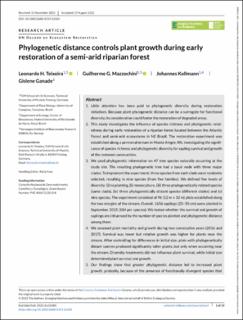| dc.contributor.author | Teixeira, Leonardo H. | |
| dc.contributor.author | Mazzochini, Guilherme G. | |
| dc.contributor.author | Kollmann, Johannes | |
| dc.contributor.author | Ganade, Gislene | |
| dc.date.accessioned | 2023-03-30T18:54:35Z | |
| dc.date.available | 2023-03-30T18:54:35Z | |
| dc.date.created | 2023-02-13T09:15:12Z | |
| dc.date.issued | 2022-10-17 | |
| dc.identifier.citation | Ecological Solutions and Evidence. 2022, 3 (4), 1-13. | en_US |
| dc.identifier.issn | 2688-8319 | |
| dc.identifier.uri | https://hdl.handle.net/11250/3061269 | |
| dc.description.abstract | 1. Little attention has been paid to phylogenetic diversity during restoration initiatives. Because plant phylogenetic distance can be a surrogate for functional diversity, its consideration could foster the restoration of degraded areas. 2. This study investigates the influence of species richness and phylogenetic relatedness during early restoration of a riparian forest located between the Atlantic Forest and semi-arid ecosystems in NE Brazil. The restoration experiment was established along a perennial stream in Monte Alegre, RN, investigating the significance of species richness and phylogenetic diversity for sapling survival and growth of the restored communities. 3. We used phylogenetic information on 47 tree species naturally occurring at the study site. The resulting phylogenetic tree had a basal node with three major clades. To implement the experiment, three species from each clade were randomly selected, resulting in nine species (from five families). We defined five levels of diversity: (i) no planting, (ii) monoculture, (iii) three phylogenetically related species (same clade), (iv) three phylogenetically distant species (different clades) and (v) nine species. The experiment consisted of 96 (12 m × 10 m) plots established along the two margins of the stream. Overall, 1656 saplings (20–50 cm) were planted in September 2015 (184 per species). We tested whether the survival and growth of saplings are influenced by the number of species planted and phylogenetic distance among them. 4. We assessed plant mortality and growth during two consecutive years (2016 and 2017). Survival was lower but relative growth was higher for plants near the stream. After controlling for differences in initial size, plots with phylogenetically distant species produced significantly taller plants, but only when occurring near the stream. Diversity treatments did not influence plant survival, while initial size determined plant survival and growth. 5. Our findings show that greater phylogenetic distance led to increased plant growth, probably, because of the presence of functionally divergent species that use resources in a complementary way. Therefore, plant phylogenetic relatedness should be considered during the design of restored communities to improve the outcomes of future restoration initiatives. | en_US |
| dc.description.abstract | Phylogenetic distance controls plant growth during early restoration of a semi-arid riparian forest | en_US |
| dc.language.iso | eng | en_US |
| dc.publisher | John Wiley & Sons Ltd. | en_US |
| dc.rights | Navngivelse 4.0 Internasjonal | * |
| dc.rights.uri | http://creativecommons.org/licenses/by/4.0/deed.no | * |
| dc.title | Phylogenetic distance controls plant growth during early restoration of a semi-arid riparian forest | en_US |
| dc.title.alternative | Phylogenetic distance controls plant growth during early restoration of a semi-arid riparian forest | en_US |
| dc.type | Peer reviewed | en_US |
| dc.type | Journal article | en_US |
| dc.description.version | publishedVersion | en_US |
| dc.rights.holder | © 2022 The Authors. Ecological Solutions and Evidence published by John Wiley & Sons Ltd on behalf of British Ecological Society. | en_US |
| dc.source.pagenumber | 1-13 | en_US |
| dc.source.volume | 3 | en_US |
| dc.source.journal | Ecological Solutions and Evidence | en_US |
| dc.source.issue | 4 | en_US |
| dc.identifier.doi | 10.1002/2688-8319.12184 | |
| dc.identifier.cristin | 2125400 | |
| dc.source.articlenumber | e12184 | en_US |
| cristin.ispublished | true | |
| cristin.fulltext | original | |
| cristin.qualitycode | 1 | |

